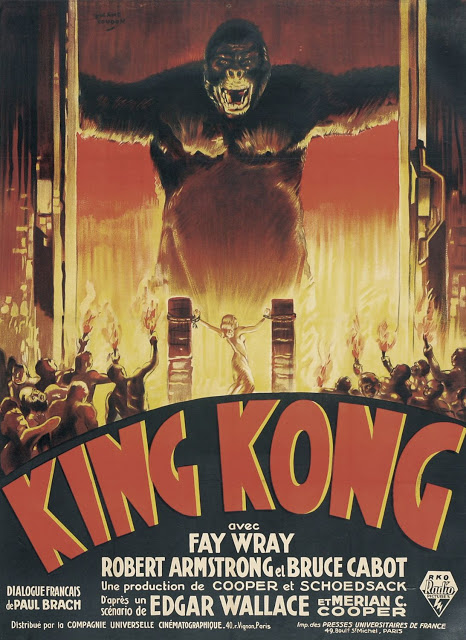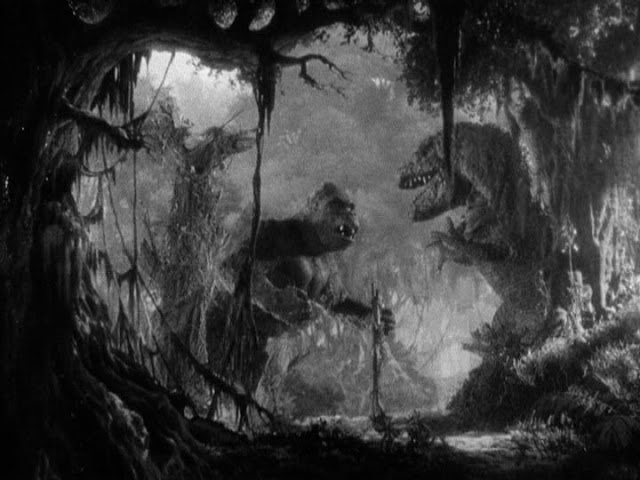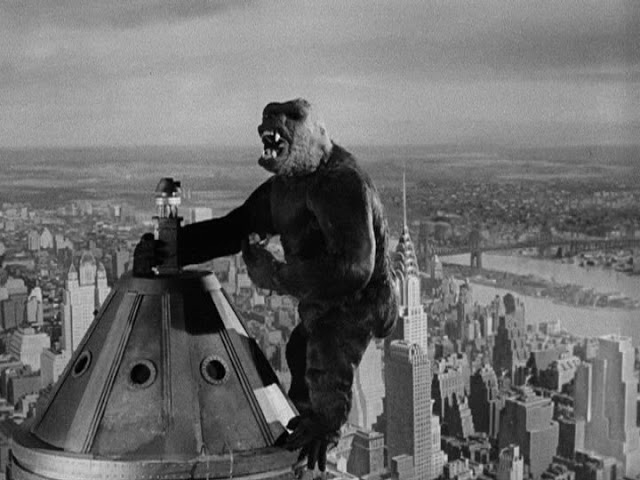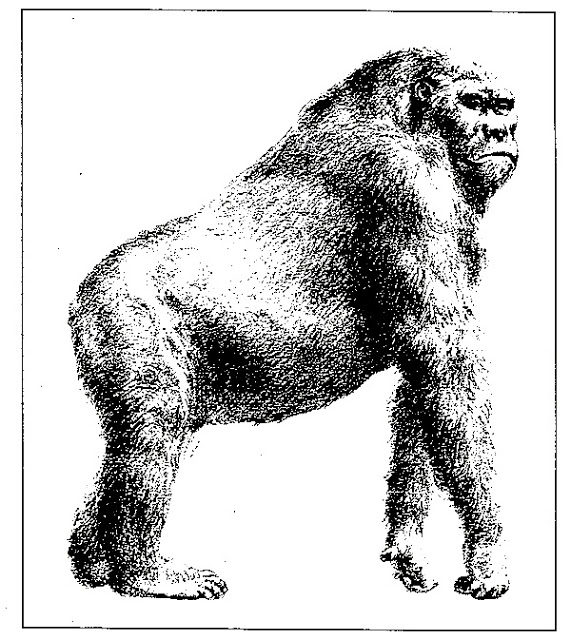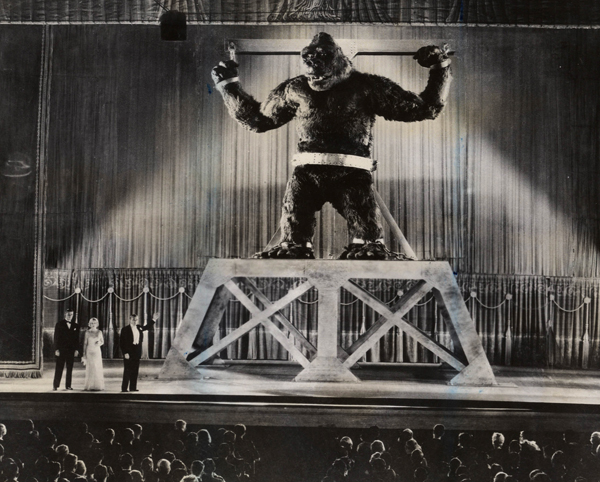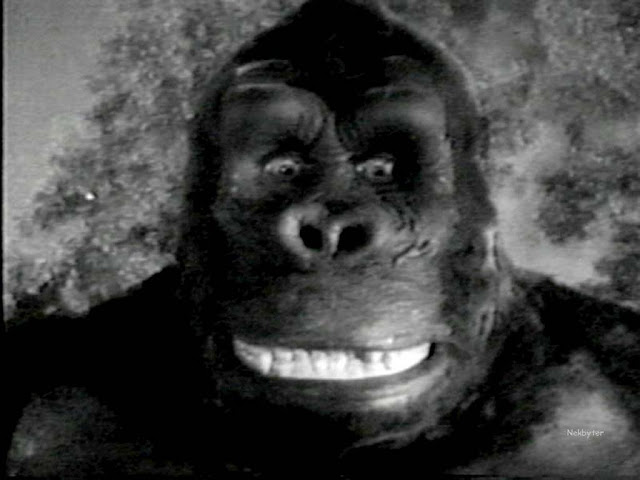The original King Kong is one of my all-time favorite movies.
I’ve owned it on VHS, DVD, recorded Ted Turner’s colorization off TV and only the lack of a Blu-ray player prevents me from buying it on that format, too. I watch it every time it shows up on TV despite that, and whenever I’m feeling particularly down or bored, I can always pop it in and cheer myself up.
My parents made the mistake of showing it to me when I was three years old and I haven’t been the same since.
Few of those who see it at that young age ever truly escape its grip.
King Kong is rightfully hailed as one of the best films of all time, but there’s not been too much done with the symbolism of the big ape himself, more as to what the film means as a whole.
So we get to tackle something well known and not so well tread.
Now that’s a treat.
King Kong is a very simple movie. I love it, but let’s be honest with it. That’s its strength, really. It’s basically the best parts of a pulp novel condensed down into movie form. Read Tarzan of the Apes and then watch King Kong. There’s not much of a difference in style or tone. That means we can read into it pretty much whatever we want.
Primarily, Kong (and Skull Island) is an embodiment of the wild unknown. Kong hails from unexplored reaches, and is something “no white man has ever seen”. He’s a natural wonder—the 8th Wonder to be specific. The inspiration for Kong initially came from the discovery of the island of Komodo. The island is known today for housing the infamous Komodo Dragons, a species of giant lizard which is one of the largest reptiles alive today and the largest lizard known (excluding snakes, which are a subset of lizards).
Unintentionally, this provides the film with an environmental message as sympathy’s shift from the humans to Kong and his efforts to fend off his prize from the other Island creatures. Once those sympathies are set, the film wisely plays them up as Kong reaches his climactic moments atop the Empire State Building.
We know he has to be killed; he’s been taken out of his element and reduced to nothing more than “a show to satisfy your curiosity”. As he dies, the music fills the audience with pathos and Willis O’Brien gives Kong operatic death throws. His death is not a victory, but a tragedy.
Leaving this message to the modern viewer: the natural world is wonderful, but people will exploit and destroy it in ignorance.
One of the few analyses I’ve seen of Kong is that comparing Kong’s predicament to those of African Americans, taken in bondage from their home and used by white folks. This, honestly, is a bit unnerving especially when the film also does the whole “Big Ape After White Woman” thing. At the time, Gorillas were thought to try and grab and rape human women. The bluff charges of Gorillas were that scary, apparently. So I’d shy away from that interpretation as it brings up far too many unfortunate implications.
Biology
There was an animal in nature similar to King Kong: Gigantopithecus.
Known from three species, it was originally thought to be a relative of gorillas, but today it’s understood to be an orangutan relative. One thing that can be agreed upon is the vast size of the animal. This great ape was the largest great ape that we know of. Growing to a height of 9 ft (3 meters) or so, but it’s hard to tell. What evidence for the animals that exists consists mainly of jaw bones and molars, which suggest it ate hard plants like bamboo.
And they went extinct around the same time as Pandas appeared. Remember that article I wrote WAY back when about Bigfoot having bears as its primary competition?
Yeah, that’s where I got it from.
Pandas killed the real King Kong.
In the movie, Kong is much larger than life, 18ft in the jungles and 21ft in the cities. This occurs because the director said “Everything has to be bigger in New York”, so the scale was altered for those scenes. This height is pretty much the limit of height for any land animal.
The body mass of Kong is like the torso of a decent sized sauropod or really huge therapod dinosaur. He would not be able to be rough and tumble much at that size, but movies rarely pay attention to the
square cube law.
Using the known species of Gorilla as baseline, he appears to be a solo male.
If there are troops of Kong in the mountains of Skull Island, he has yet to form one of his own. He could be a deviant, adopting ‘brides’ as foster children, but having no known way to raise them. This odd inter-species relationship thing is not unheard of in the animal kingdom and not even in primates, but it is very rare.
Kong, like other gorillas, would probably be an herbivore, eating hard plants, leaves and so on. This would actually make him rather lethargic overall. A lot of these little biological details were directly demonstrated or expanded upon in Peter Jackson’s take on Kong.
To be perfectly honest, he built most of those things on the foundation the original film set up. Seeing Kong munch bamboo like celery is a fun little nod to the really obsessive fans of Kong to show “Yes, we really did our homework.”
But that Kong is worth his own article.





































































































